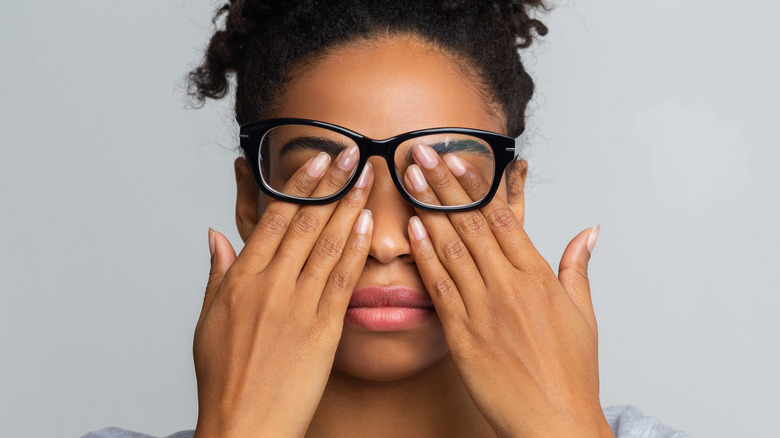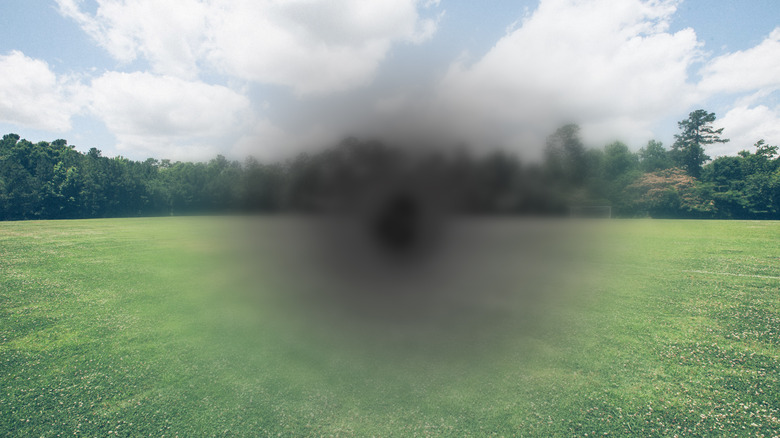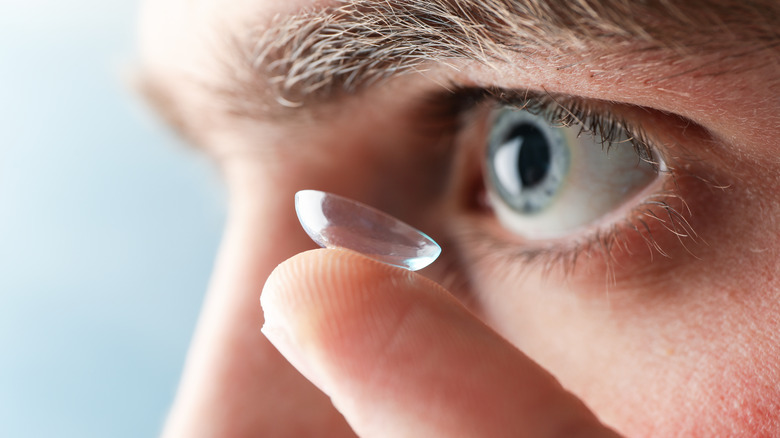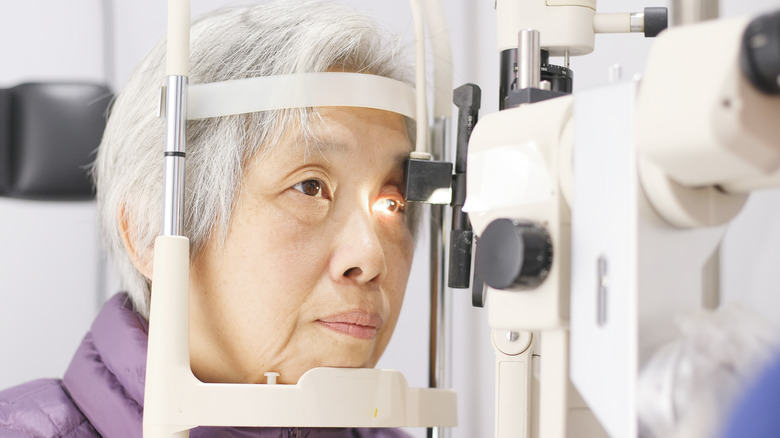You Should See An Eye Doctor If This Happens To You
They say the eyes are the window to the soul. Who says? Well, how about: Any. Article. Ever. Written. About. Eyes. For the record, though this idea is often attributed to Shakespeare, its actual origin is obscure.
It might be more accurate to call the eyes the window to the body. There's plenty to be learned about a person by examining their eyes. Eye color, for example, has been linked to a risk of alcohol dependence and certain skin conditions. And did you know that everyone with blue eyes probably has a common ancestor? Research suggests that changes in the eye can be an early signal of Alzheimer's disease, and it's already been established that an eye exam can detect signs of everything from high cholesterol to multiple sclerosis. Your eyes have plenty to tell you, but it's not always easy to get what they're saying. So here's a guide to help you know when the message is an urgent one.
Blood in your eye may or may not be a problem
When the white of your eye is showing areas of blood-red, it's an alarming sight for sure. But it's not necessarily cause for alarm. "When the white part of the eye is red, it's typically what's called a subconjunctival hemorrhage," ophthalmologist Davinder S. Grover, MD, clinical spokesperson for the American Academy of Ophthalmology, explained to Health Digest. "It typically happens when a blood vessel breaks around the eye and it looks very worrisome and scary, but it's actually nothing to be too worried about at all." The tiny blood vessels on the eye can burst and leak due to irritation, dry eyes, a cough or sneeze, or anything that causes a short blood pressure spike. The problem will resolve on its own.
The key point here is that this type of redness isn't accompanied by other symptoms; any pain or vision change that accompanies blood in the eye does indicate a visit to the eye doctor is in order. Also know that bloodshot eyes are a separate problem, best treated with over-the-counter artificial tears to soothe your irritated eyes. And avoid products that promise to reduce red eye. "They make your eyes white, but then your blood vessels get used to having that chemical around, and when you stop using the drops your eyes get even redder," Dr. Grover explains.
See a doctor whenever you have sudden and persistent vision changes
There are any number of vision-related symptoms that indicate potential eye health problems. You might see dark spots in your field of vision, or your vision might be partially blocked by a dark shadow or curtain-like shape. Your vision might be distorted; you might have double vision or tunnel vision; you might see flashes of light, or halos around light sources. You might see a sudden increase in "floaters," those translucent specks and strands created by clumps of cells inside the eye.
Rather than memorize all these symptoms, your best bet is to consider any sudden, persistent, loss or change of vision to be cause for a doctor visit. If it's quick flashes of light, or a curtain dropping over your vision, consider it an emergency: your retina may have become detached.
One fairly common symptom that's typically not worrisome: seeing zigzags of light or a shimmering in your vision. "This is called an ocular migraine, and typically lasts for 10-20 minutes," ophthalmologist Davinder S. Grover told us. It's harmless, though poorly understood, and can occur with or without an actual migraine headache. In people who get them, ocular migraines tend to occur with stress.
If you wear contacts, know the signs of an infection
Contact lenses are a popular alternative to wearing eyeglasses, but they require proper care and cleaning. Otherwise, there's a chance that they'll deliver germs that cause inflammation of the cornea, the clear dome that covers the eye. This condition is called keratitis, and in severe cases it can cause blindness or require a corneal transplant, according to the Centers for Disease Control and Prevention. Note: It's not possible to transplant an entire eye, but a cornea from an organ donor can be transplanted. It's also possible to transplant eyelashes, eyelids, and tear ducts.
Symptoms of keratitis include irritated, red eyes, watery eyes or discharge, blurred vision, and eye pain even after your contact lenses are removed. It can be caused by a virus, bacterium, fungus, or even a parasite, including some microbes that are commonly found on or around the human body. These germs might take up residence on the surface of your contacts if you don't care for them properly. So always wash your hands before handling your contact lenses, and take the appropriate steps to clean and care for them. If you're having symptoms, stop wearing the lenses until you can see an eye doctor (via CDC).
What if I wake up with my eyes crusted over?
"Crusty eyelids in the morning, sailor take warning," is how a pirate might remember it (especially if he's wearing one eyepatch already). Crusty morning eyelids, along with red in the whites of the eye, and excess tears, are classic symptoms of pinkeye, also called conjunctivitis, said ophthalmologist Davinder S. Grover. "Ninety percent of the time, it's caused by adenovirus, a virus which also causes the common cold," he told Health Digest. Pinkeye is highly contagious, but you can take steps to keep it from spreading through your household: Avoid touching your eyes, and wash your hands frequently.
Pinkeye isn't associated with pain or vision changes, so if you're not having those symptoms you can generally treat it on your own using cold compresses and over-the-counter artificial tears for relief until the symptoms go away. If you do consult your family doctor, question any recommendation to use an antibiotic. "That's one of my pet peeves," Dr. Grover said. "The cause is not a bacteria, it's a virus." Not only will antibiotic drops not affect a virus infection, they may be more irritating to your eyes than the virus itself.
Help, my contact lens won't come out!
A contact lens may be slippery, but it should stay more or less where it's supposed to be, i.e., over the pupil of your eye. If it slips under your eyelid, you may have what's called a "retained contact lens." Sometimes this can cause a bacterial infection, according to case studies reported in the medical journal Eye and Contact Lens: Science and Clinical Practice.
The good news is that a contact lens can't end up lost behind your eyeball — that's physically impossible, reported Health. But contact lenses can dry out if you sleep with them in your eyes. And when they lose their elasticity, they can get stuck under your eyelids. If you can't find a stuck lens, gently flip each eyelid out to see if it's slipped underneath. When you spot it, do not try and pull it loose as you might scratch your cornea. Use the drops that came with your contacts to float the lens off your eye. If it still won't budge, it's time to see the eye doctor.
Warning, low vision ahead
If you're in your 40s, guess what? You may already have cataracts in your eyes (via Johns Hopkins Medicine). "It's a gradual clouding of the lens," ophthalmologist Davinder S. Grover explained to Health Digest. "With time, our hair gets a little grayer, and our lens gets a little cloudier." Cataracts make the lens of the eye stiffer and less able to focus on close objects, which is why many people end up sheepishly trying on the wares at that rack of reading glasses in the supermarket. (Don't kid yourself, you'll turn up there sooner or later.)
For most people, cataracts produce a very gradual decline in overall vision across the decades: you need a little more light to read, colors are a little less vivid. But there's no cause for concern unless your low vision symptoms prevent you from enjoying your life. "When a patient tells me they have to rush to get home before dark to make sure they don't have to drive at night, that's when we consider taking action," Dr. Grover said. Surgery to remove cataracts is one of the safest and most predictable eye surgeries, he adds.
Any eye drama requires a doctor visit
"Thankfully, the most of the concerning things about the eye and eye health are not subtle," ophthalmologist Davinder S. Grover told Health Digest. That's why it's a good rule to take any sudden or dramatic eye-related symptoms seriously. This includes any vision changes or distortions, pain, an increased number of eye floaters, or increased sensitivity to light. A gritty feeling in the eye or a thick or mucous-like discharge could be signs of an infection, according to the Cleveland Clinic.
And don't take eye symptoms lightly because they're not accompanied by pain or discomfort. A detached retina, for example, can cause you to see quick flashes of light or a dark shadow across your field of vision without other sensations. "It's on the list of things that cause painless loss of vision," Dr. Grover notes. If you've had eye surgery in the past, that's an extra reason to consult your eye doctor about any new symptoms.
So, you got klonked in the eye...
So maybe you're an MMA fighter, or maybe a clown nailed you in the face with a more-solid-than-usual banana cream pie. Whatever the reason, when you take a shot to the eye, it's better to be safe than sorry and get the injury checked out, according to the American Academy of Ophthalmology. A serious eye injury isn't always obvious. Definitely see a doctor if an injury causes pain, a black eye, or vision problems. Consider it an emergency if you have ongoing pain or trouble seeing; the eyelid is torn or there's something stuck in the eye; one eye doesn't move as well, or sticks out more than, the other; the pupil is an unusual size or shape, or there's blood in the clear part of the eye.
Use a cold compress, held to the eye without pressure, to relieve pain. Forget the folk remedy of holding a steak to it, that's like to lead to an infection. Plus do you want your eye to smell like meat? Gross.
If the eye's been cut or punctured, don't rinse it; cover it up. The bottom of a paper cup taped to the bones around the eye makes a good shield. Then get to the ER or your eye doctor ASAP.
Is there something in your eye that won't come out?
Your eye is like a private after-hours club. All kinds of riff-raff tries to get in — dust, sand, your own eyelashes. And usually, it's NBD to bounce the party crashers. The key is to 1) not rub the affected eye, which could make things worse and 2) give your eye the chance take care of its own biz by blinking and letting tears wash out the offenders. If that doesn't do the trick, your next move is to try and flush the particle(s) away with running water or saline solution (via American Academy of Ophthalmology).
If you can't get the intruders out, it's time to visit the doctor's office — especially if you're dealing with man-made materials like particles of glass or metal, which can cause damage to the eye if not removed. You should also see the doc if it feels like there's something in your eye but you don't know the cause. A number of conditions can trigger this symptom. You might have an infection, for example, or a clog in your eyelid's oil gland (which can produce an eyelid bump called a chalazion). You might have an eyelash growing against your eyeball (a condition called trichiasis). Or your cornea might be scratched or cut.
How to handle a twitchy eye
Uh, is there some reason you keep winking? Are we in a heist movie together or something? No? Well, it could be that you're experiencing involuntary spasms of the eyelid, also known as an eyelid twitch or tic. Sometimes this condition is brief, but it can last for hours, or even days.
Stress and fatigue are big contributors to a twitching eyelid, according to the American Academy of Ophthalmology, so taking a break, relaxing, or getting some sleep are likely to tame the tic. Cutting back on caffeine can also bring relief. If your twitch doesn't go away on its own, or seems to be getting worse, a doctor visit is called for.
Twitching that causes your whole eye to close is called blepharospasm, and it may need to be treated with injections, medication, or surgery. If the spasm involves other muscles on the side of your face as well as the eyelids, the condition is termed a hemifacial spasm, and it's usually treated by injection to relax the affected nerves (via AAO).
If you have diabetes, your eyes are at risk
The leading cause of vision loss in people between ages 18 and 64? Diabetes. Eye problems specific to diabetes include macular edema (swelling of the retina, the light-sensitive tissue in the back part of the eye) and retinopathy (damage to the blood vessels of the retina). The disease can also raise the risk of cataracts (lens cloudiness) and glaucoma (damage to the optic nerve), according to the American Diabetes Association.
Diabetes threatens the eyes because it causes high blood sugar levels that can damage the tiny blood vessels that feed the retinal tissue. Fluid can leak from the damaged blood vessels, affecting vision and causing swelling. Weak blood vessels can break, bleed, and cause scar tissue to develop, interfering with vision or even causing the retina to detach.
The good news here is that a yearly eye exam can prevent 95% of vision loss caused by diabetes. The American Diabetes Association recommends that everyone diagnosed with diabetes (type 1 or 2) get an eye exam with dilation (meaning the eye doctor uses drops to widen your pupils) every year to check for complications. Controlling your blood sugar can also help prevent problems, and keep existing vision issues from getting worse.
Don't put up with dry eyes
More than 16 million Americans have dry eye, meaning they aren't making enough tears to keep their eyes lubricated. This might not be surprising when you consider that staring for too long at a computer or phone screen can cause this problem. If you fit into this statistic, know that cutting down on the screen time, staying hydrated, and lubricating your eyes with over-the-counter artificial tears can help (via National Eye Institute).
If the problem won't go away, it's worth going to an eye doctor to address the issue. A study conducted in the U.K. found that people diagnosed with dry eyes or who had symptoms (including sensations of dryness, soreness, grittiness, or burning) were more likely to have mobility issues, anxiety, and depression. Severe symptoms had a negative effect on social and emotional function and workplace productivity. Getting your dry eyes assessed by a doctor opens up a range of treatment options, from prescription medications to tear-duct plugs that keep tears in your eyes longer.
Your eyes work just fine? Keep it that way
Sometimes called the "silent thief of sight," glaucoma is a condition in which the fluid inside the eye doesn't drain out the way it should, causing a rise in pressure that damages the optic nerve. Over time, damage to the nerve cells in the optic nerve causes blind spots and, if not treated, complete blindness, says the American Academy of Ophthalmology.
There are two major types of glaucoma, but neither has any warning signs or causes symptoms until it starts doing irreversible damage to your eyesight. This is one reason that the AAO recommends everyone get a baseline eye exam at age 40 (or sooner if you have diabetes, high blood pressure, or a family history of eye disease).
The baseline exam determines how often you should get follow-up exams to screen for glaucoma and other eye and vision problems. Not only that, but regular eye exams can turn up signs of other health problems, including brain tumors, certain types of cancer, diabetes, high cholesterol, vascular disease, Lyme disease, and medication toxicities.
Know your family's eye history
A number of eye diseases are genetic, including glaucoma, macular degeneration, and cataracts. Knowing that there's a history of these illnesses in your family can help you understand your own risk. For example, a family history of age-related macular degeneration could mean you have a 50% chance of developing it. A family history of glaucoma could make your risk four to nine times greater. Since many eye diseases progress without early warning signs, knowing when you're at increased risk could is key to protecting your sight (via American Academy of Ophthalmology).
If you're not already aware of it, a good strategy to assess the prevalence of eye disease in your family is to ask about it at family get-togethers, suggests the AAO. Discuss what you find with your eye doctor. If you haven't had a baseline exam with ophthalmologist, consider scheduling one. While adults are recommended to have an exam at age 40, those with eye disease in their family's medical history should do so sooner.















